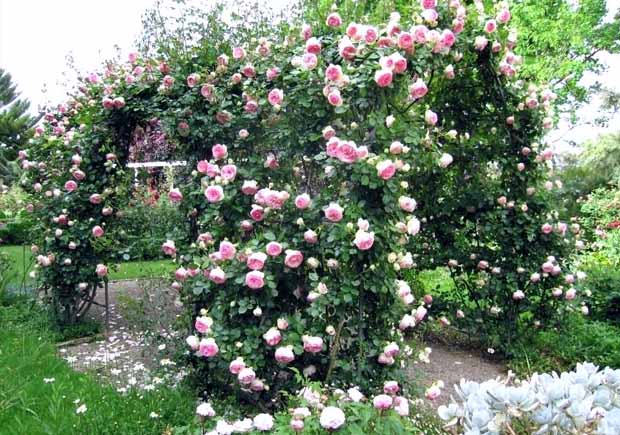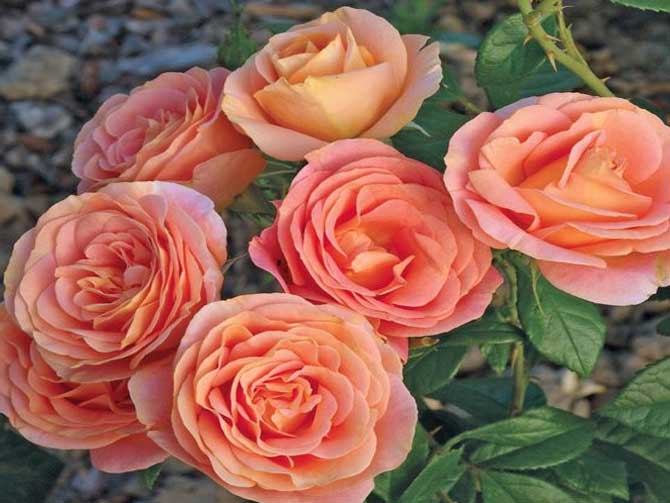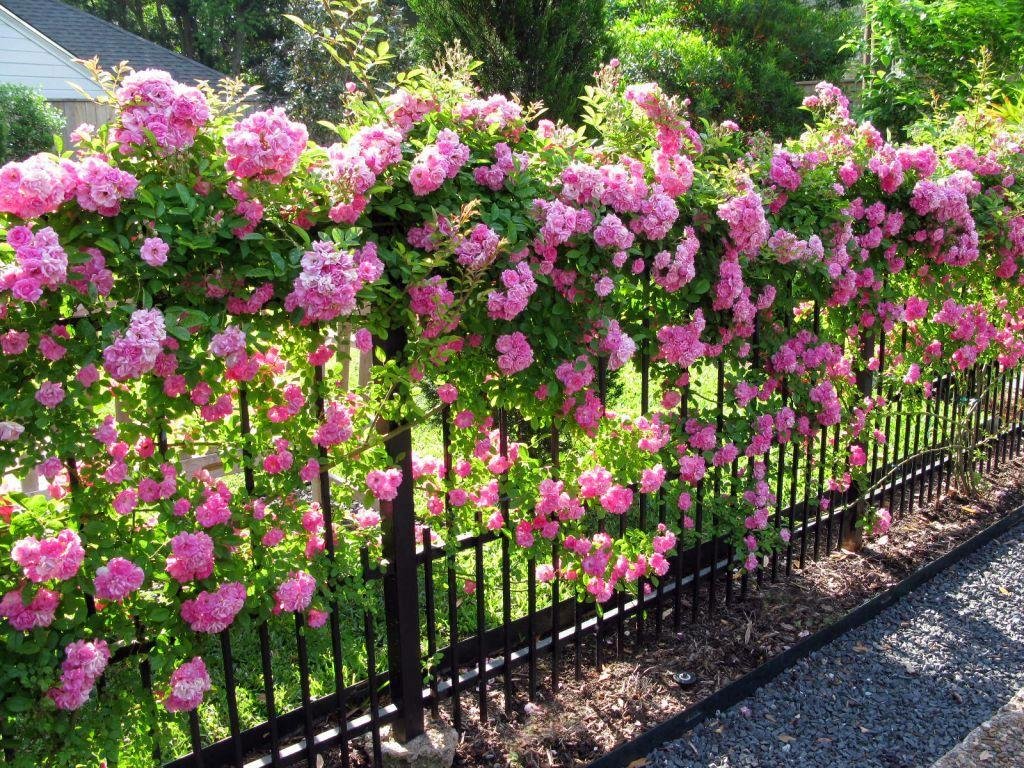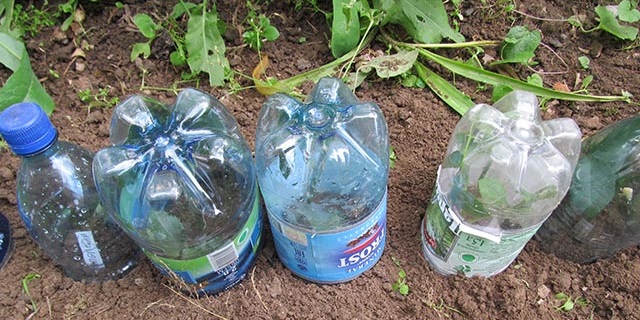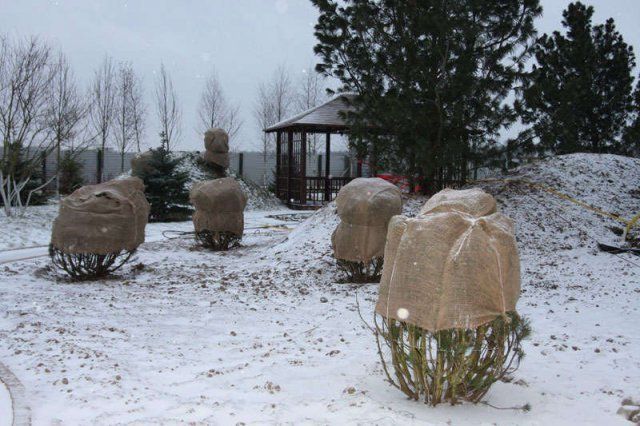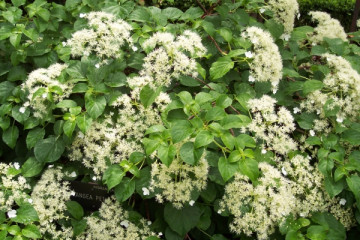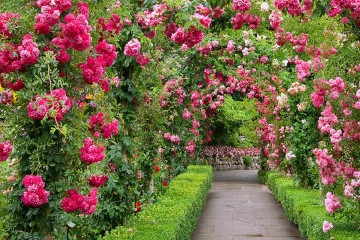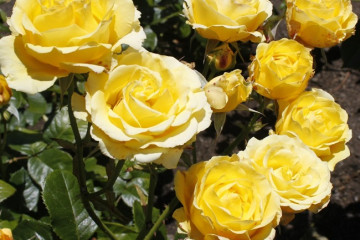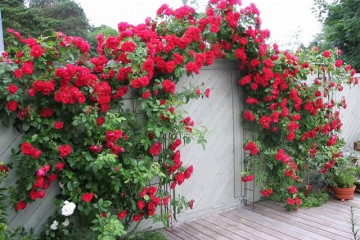Climbing rose - planting and care for beginners
Content:
Climbing rose includes wild rose and some varieties of garden flowers, a special feature of which are long stems. These are very beautiful roses, popular among gardeners.
Climbing roses - what is this variety
Climbing roses are a generalized concept that does not have a general description, since it combines many varieties and forms of flowers. But there is a classification according to which the following 3 groups of roses are distinguished:
- Curly roses or ramblers. They have long flexible branches, creeping or arched. Their length is up to 5 m and more. The shoots are green, the leaves are glossy, with a rich herbal color. Flowers can be double, simple or semi-double, with a diameter of about 25 mm. The aroma is weak. The plant produces numerous buds.
- Large-flowered or climbing - the result of selection between ramblers and tea, hybrid tea roses and floribunda. The length of their branches is about 4 m, the flowers are from 4 cm in diameter, in shape they are similar to hybrid tea roses. Abundant flowering.
- Climing - are distinguished by the longest shoots and large flowers with a diameter of 4-11 cm. Flowers are single or make up lush inflorescences. Climings are grown only in southern regions with mild and warm winters.
Advantages and disadvantages
Before planting a climbing rose, you need to find out what advantages and disadvantages it has. Each variety has its own characteristics.
Pros of ramblers:
- autumn lignification of shoots, which increases frost resistance;
- pliability of young shoots, which makes it possible to roll them into a ring and cover them with high quality before winter;
- universality of use in design.
The disadvantage of ramblers, in which many see their advantage on the contrary, is the one-time appearance of color. It ends in the middle of summer, which makes it possible to prepare the rose for winter.
Climber advantages:
- variety of varieties;
- the buds are large, lush.
The disadvantage of climbers is that they have very rigid, inflexible branches that cannot be wrapped around columns or formed into arches.
Popular varieties of climbing roses
There are many varieties of climbing bushes, but among them the following roses are especially popular:
- Bobby James - height up to 8 m, crown width about 3 m. Leaves are small, rich green, practically invisible behind numerous buds. The culture produces white buds with a delicate yellow tint. The diameter of the flowers is from 4 to 5 cm. The aroma is musky.
- Santana - height is about 4 m, flowers are velvety, semi-double, with a diameter of 4 to 10 cm, red.
- Elf - grows up to 2.5 m, the span of the crown is about 1.5 m. The flowers are densely double, with a diameter of 14 cm. The buds are white with a green tint. The smell is fruity.
- Lagoon - 3 m in height, span - 1 m. Inflorescences racemose, double flowers, up to 10 cm in size. Color - dark pink.
- Sympathy - height 3 m, bush spreads up to 2 m. Flowers are scarlet, small. Blooms profusely, several times per season.
Outdoor rose care, tips for beginners
Any climbing rose is a rather whimsical plant that requires careful and regular care. There are a number of rules and recommendations that beginners in gardening must strictly follow.
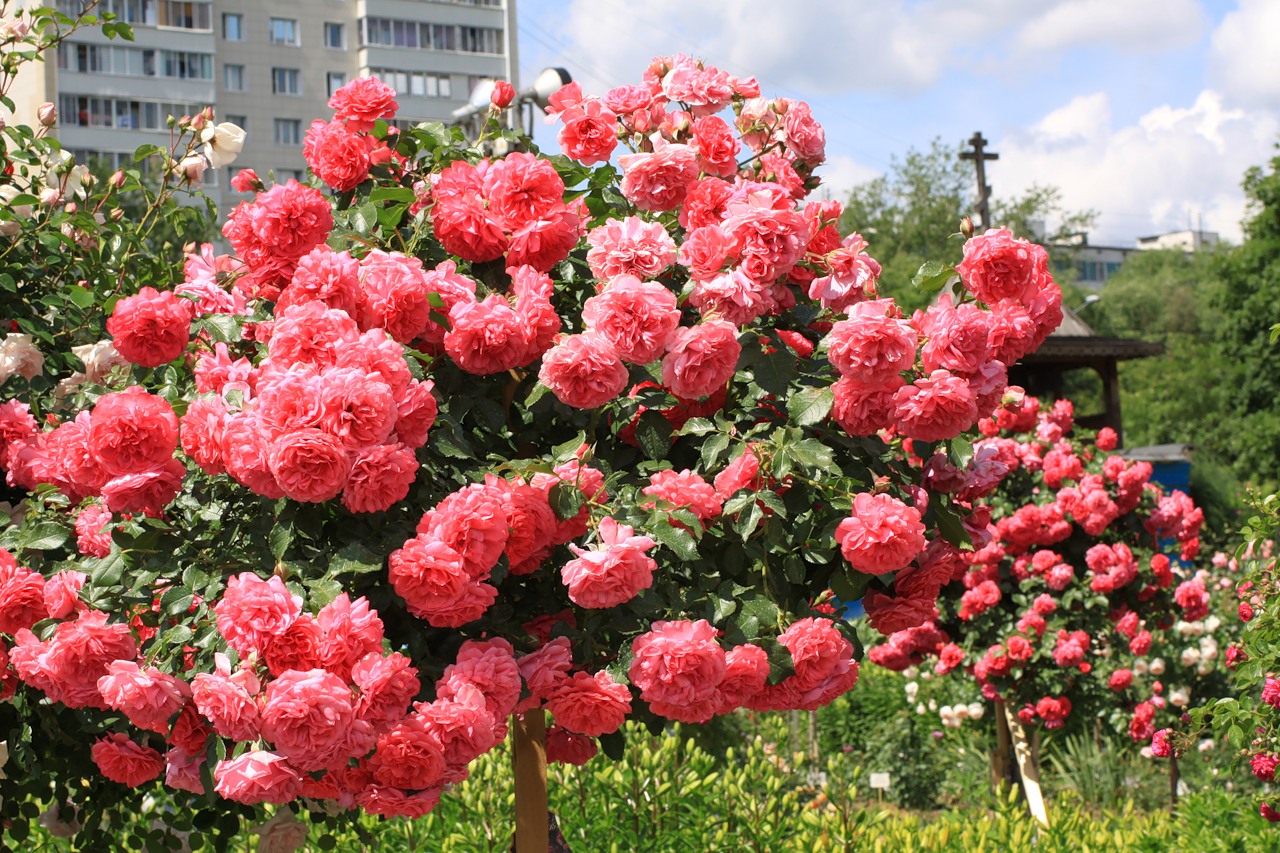
Proper care is a guarantee that it will be possible to grow unique beauty, which looks especially bright on the trunk.
Watering and feeding
The weaving rose is drought-resistant, so it does not need abundant and frequent watering. It is enough to moisten the soil once a week. Each bush has about 10 liters of water. 2-3 days after watering, loosening of the soil to a depth of 5 cm is mandatory to ensure the flow of oxygen to the roots.
Regular fertilization is mandatory:
- After planting, recharge is applied at the beginning of autumn - potash compounds are used.
- Up to 2 years old, the rose needs organic and mineral supplements, the use of which alternates.
- Only organic compounds are suitable for flowers from 3 years old and older. The preferred feed is a mixture of 1 L of manure, 10 L of water and 1 cup of wood ash.
During the period of active growth, the flower is fertilized up to 5 times.
Correct garter
Growing and caring for a climbing rose requires the construction of supports for it, otherwise the shoots will lie on the ground. The following are used as support:
- arches;
- arc-shaped metal rods;
- sieve;
- trellis walls;
- fence;
- walls of the house;
- dry trees.
In caring for climbing roses, it is necessary to correctly tie them to the support. This is done by the twine method. To ensure abundant flowering, the main branches are tied horizontally. New shoots will appear from them, directed upwards, with a large number of buds.
Transplant and reproduction
An adult bush flower is transplanted only if the planting site was initially chosen incorrectly, which negatively affects the development of the plant and its flowering. The transplant time is September or the first days of November, or in April, but only until the buds appear. Algorithm for the transplant procedure:
- The rose is carefully removed from the support. The tops of young shoots are pinched so that they are more woody.
- Branches over 2 years old are cut off.
- The longest stems should be cut to half the length - this does not apply to ramblers.
- The bush is dug in a circle. When digging from the center of the plant, it is necessary to retreat a distance of 2 shovel bayonets.
- You need to dig out the rose very carefully, without damaging the root system, and, if possible, completely remove it from the old hole.
- The roots of the excavated plant are cleared of old soil. Damaged roots are removed.
- The rose is placed in a new prepared hole, covered with earth. The soil is compacted and watered.
The division of flowers is carried out by cuttings, planting with seeds and layering.
Cuttings:
- Both flowering and faded stems are used as cuttings. They are cut from the second half of July to early August.
- The lower cut is made oblique, at an angle of 45 degrees, under the kidney. The upper cut is straight, at the maximum height from the kidney.
- Each cutting should have at least 2 internodes.
- The lower leaves are removed, the upper leaf plates are cut in half.
The cuttings are buried 1 cm into the soil, covered with a jar on top. When watering, you do not need to remove the jar.A growth promoter should be used only in the case of propagation of roses with a long rooting period.
Layering method:
- In April - May, a small incision is made over the upper kidney.
- The notched branch descends to the ground, where a small groove has been prepared. Previously, humus is poured onto the bottom of the groove, which is covered from above with a thin layer of earth.
- The lowered branch must be fixed in several places, then covered with soil.
- When caring for the layering, the systematic watering is important.
- The following spring, the rooted cut can be cut from the mother bush and transplanted to a permanent place.
Pruning
To make the rose bush attractive, it must be pruned. This will help increase the number of buds.
Features of trimming:
- In roses that give color only once a season, faded branches are removed, they need to be cut off at the root. The procedure is carried out at the end of October.
- In bushes that bloom twice, the main shoots are cut to the base. This is done after wintering, when it is warm, and when the rose turns 4 years old.
After wintering, sanitary cleaning is carried out, during which branches that have frozen and turned black are removed.
Wintering curly roses
Planting and caring for a climbing rose outdoors requires shelter for the winter. This is done as follows:
- Remove all leaves from the branches.
- Bend the stems to the ground. This must be done very carefully so as not to damage or break them.
- The safest way is to build a shield over the branches like a triangular roof. If the winters are cold, there shouldn't be any crevices. Conversely, during warm winters, it is necessary to provide the roses with ventilation. The bushes should not come into contact with the shields, as moisture accumulates on them, which can lead to rotting of the branches. From above, the shield is covered with a film.
- If the rose is on the arch, you can wrap it up directly on the support - wrap it with spruce branches or burlap and fix it on top with ropes.
Diseases and pests
Diseases that can infect branchy roses:
- Bacterial cancer - the appearance of growths on the branches, soft to the touch, which harden over time. The disease is not cured. The affected branches are cut, the cuts are processed with copper sulfate (3%).
- Coniotirium is a fungal disease. The bark is covered with spots of red-brown color. The stems are cut and burned. Prevention - the introduction of nitrogen fertilizers to strengthen the flower.
- Powdery mildew - a bloom on the leaves of white. The affected parts are destroyed, the bush is treated with copper or iron sulfate.
- Black spot - the leaves are covered with black spots. Treatment - treatment of the bush with Bordeaux liquid.
Pests - aphids, spider mites, leaf rollers. The parasites are collected by hand, after which the bush is treated with soapy water, in advanced cases, insecticides are used.
The use of climbing roses in landscape design
Knowing how to care for a climbing rose, from a small branch you can quickly grow a real garden masterpiece, the queen of a summer cottage and a personal plot. In landscape design, roses are used both solo, on gazebos, arches, walls, and in combination with other flowers. In the garden, it is recommended to combine a rose with flowers such as:
- daylilies;
- clematis;
- asparagus;
- sage;
- aconite;
- delphinium.
The intertwining roses are incredibly beautiful. They give a bright flavor to the garden or flower bed. Planting and caring for these flowers is not very difficult.It is enough to create comfortable conditions for them - watering, loosening, thinning and cleaning, so that they can grow strong and delight with their numerous lush flowers.
